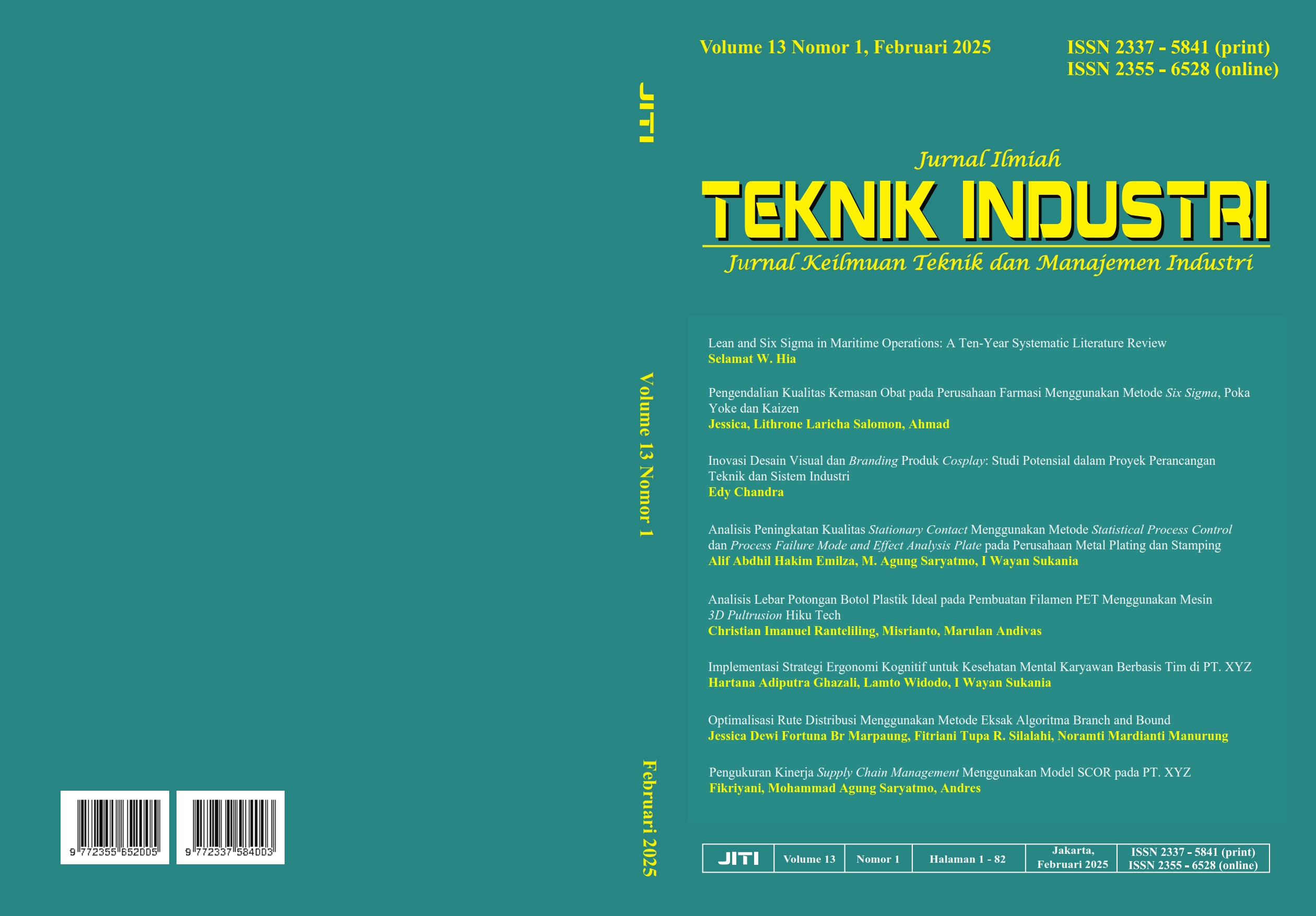PENGENDALIAN KUALITAS KEMASAN OBAT PADA PERUSAHAAN FARMASI MENGGUNAKAN METODE SIX SIGMA, POKA YOKE DAN KAIZEN
Isi Artikel Utama
Abstrak
This study was conducted at a pharmaceutical manufacturing company, focusing on the blistering process of capsule products. Quality control issues were identified, particularly defects that do not meet company standards. The objective of this research is to identify the root causes of defects and propose improvements using the Poka Yoke and Kaizen methods. The study is limited to defects found in capsules that have passed the blistering stage, including crushed capsules, dirt contamination, misprinted expiration dates, and empty capsules. The capsules used in the study already meet company standards before processing. The analysis applies the Six Sigma methodology with the DMAIC approach (Define, Measure, Analyze, Improve, Control). Results from January 2024 to March 2025 show a DPMO value of 9100.625 and a sigma level of 3.86. The Pareto diagram indicates that the most dominant defects are crushed capsules (35.8%) and dirty capsules (30%). Based on FMEA analysis, the highest RPN values are caused by capsule misalignment in the blister machine (for crushed defects) and powder residue sticking to the sealing area (for dirty defects). Improvements are proposed using Poka Yoke techniques and continuous improvement through Kaizen, specifically applying the 5M and 5S principles.
Rincian Artikel

Artikel ini berlisensiCreative Commons Attribution-NonCommercial-ShareAlike 4.0 International License.

All publications by Jurnal Ilmiah Teknik Indsutri (Jurnal Keilmuan Teknik dan Manajemen Industri ) [p-ISSN: 2337-5841, e-ISSN: 2355-6528] is licensed under a Creative Commons Attribution-ShareAlike 4.0 International License.
Referensi
[1] B. Shonata, “Analisis Kecacatan pada Proses Produksi Sepatu engan Menggunakan Metode Six Sigma dan Failure Mode Effect Analysis ‘Studi Kasus di UD. Giri Jaya,” JUSTI (Jurnal Sistem Dan Teknik Industri), vol. 4, no. 4, pp. 526–533, 2023.
[2] S. Suhartini and M. Ramadhan, “Analisis Pengendalian Kualitas Produksi Untuk Mengurangi Cacat Pada Produk Sepatu Menggunakan Metode Six Sigma dan Kaizen,” MATRIK : Jurnal Manajemen & Teknik Industri-Produksi, vol. 22, no. 1, pp. 55–64, 2021.
[3] D.G. Tambunan, B. Sumartono, and H. Moektiwibowo, “Analisis Pengendalian Kualitas dengan Metode Six Sigma dalam Upaya Mengurangi Kecacatan pada Proses Produksi Koper di PT SRG,” Jurnal Teknik Industri, vol. 9, no. 1, pp. 58–77, 2020.
[4] R. Sri, P.E. Yuliana, and K. Kelvin, “Penerapan Metode Six Sigma untuk Analisis Pengendalian Kualitas Produk Sepatu pada Industri Sepatu di Sidoarjo,” Jurnal Teknik Industri, vol. 25, no. 1, pp. 27-37, 2022.
[5] A. Wiswandani and A. Suharsono, “Analisis Pengendalian Kualitas pada Proses Making Produksi Diplomat Mild Reborn di PT. Gelora Djaja Surabaya,” Jurnal Sains dan Seni ITS, vol. 8, no. 2, pp. 2337-3520, 2019.
[6] L.E. Laurentine, L.O.A.S. Tosungku, and L.D. Fatimahhayati, “Analisis Pengendalian Kualitas Produk Sepatu Menggunakan Metode Six Sigma dan Kaizen pada CV. Sepatu Sani Malang Jawa Timur,” Profisiensi: Jurnal Program Studi Teknik Industri, vol. 10, no. 1, pp. 41–48, 2022.
[7] Febriansyah, N. Ilmi, and A. Lawi, “Penerapan Metode Six Sigma dalam Menganalisis dan Menanggulangi Defect Rate pada Pengelasan Tubular,” Jurnal Teknik Industri (JURTI), vol. 1, no. 2, pp. 128-137, 2022.
[8] R.P. Wardhani, “Penggunaan Metode Statistik Pareto Chart dalam Pengendalian Mutu Produk Perusahaan,” Jurnal Teknik Mesin: CAKRAM, vol. 5, no. 2, pp. 56–61, 2022.
[9] T. Widianti and H. Firdaus, Penilaian Risiko Instansi Pemerintah dengan Fuzzy - Failure Mode and Effect Analysis, LIPI Press, Jakarta, 2017.
[10] S.A. Mahfudz and Y.T. Hapsari, “Analisis Perbaikan Kualitas dengan Metode Six Sigma dan Kaizen Untuk Mengurangi Jumlah Reject Produk Gerabah,” Journal Of Industrial Engineering And Technology (Jointech) Universitas Muria Kudus Journal homepage, vol. 5, no. 1, pp. 1–12, 2024.
[11] N.Y. Nababan, A. Faizal and M.E. Jatnika, “Usulan Perbaikan Defect pada Sablon Plastik Menggunakan Metode Poka Yoke di CV. Bayor Print 69,” Jurnal Ilmiah Teknologi Informasi Terapan, vol. 6, no. 2, pp. 167-175, 2020.
[12] M. Basjir, S. Suhartini and N. Robbi, “Peningkatan Kualitas Produk dengan Metode Six Sigma dan Kaizen,” Jurnal Serambi Engineering, vol. 9, no. 3, pp. 9493 - 9502, 2024.
[13] A.R. Dewanto and A.Z. A. Faritsy “Aplikasi Six Sigma dan Kaizen Untuk Mengurangi Cacat Produk,” Jurnal Multidisiplin Ilmu Akademik, vol. 1, no. 4, pp. 163-172, 2024.
[14] E. Herjanto, Manajemen Operasi, Jakarta: Grasindo, 2020.
[15] Amirullah and P.D. Masruroh, “Implementasi Konsep Kaizen dalam Meningkatkan Kinerja Karyawan,” Akademika, vol. 18, no. 1, pp. 66-76, 2020.
[16] F.B. Ongan, W. Kosasih and H.J. Kristina, "Penerapan Lean Six Sigma di Perusahaan Farmasi pada Proses Pengemas Produk Blister," Jurnal Mitra Teknik Industri, vol. 3, no. 3, 2024.



